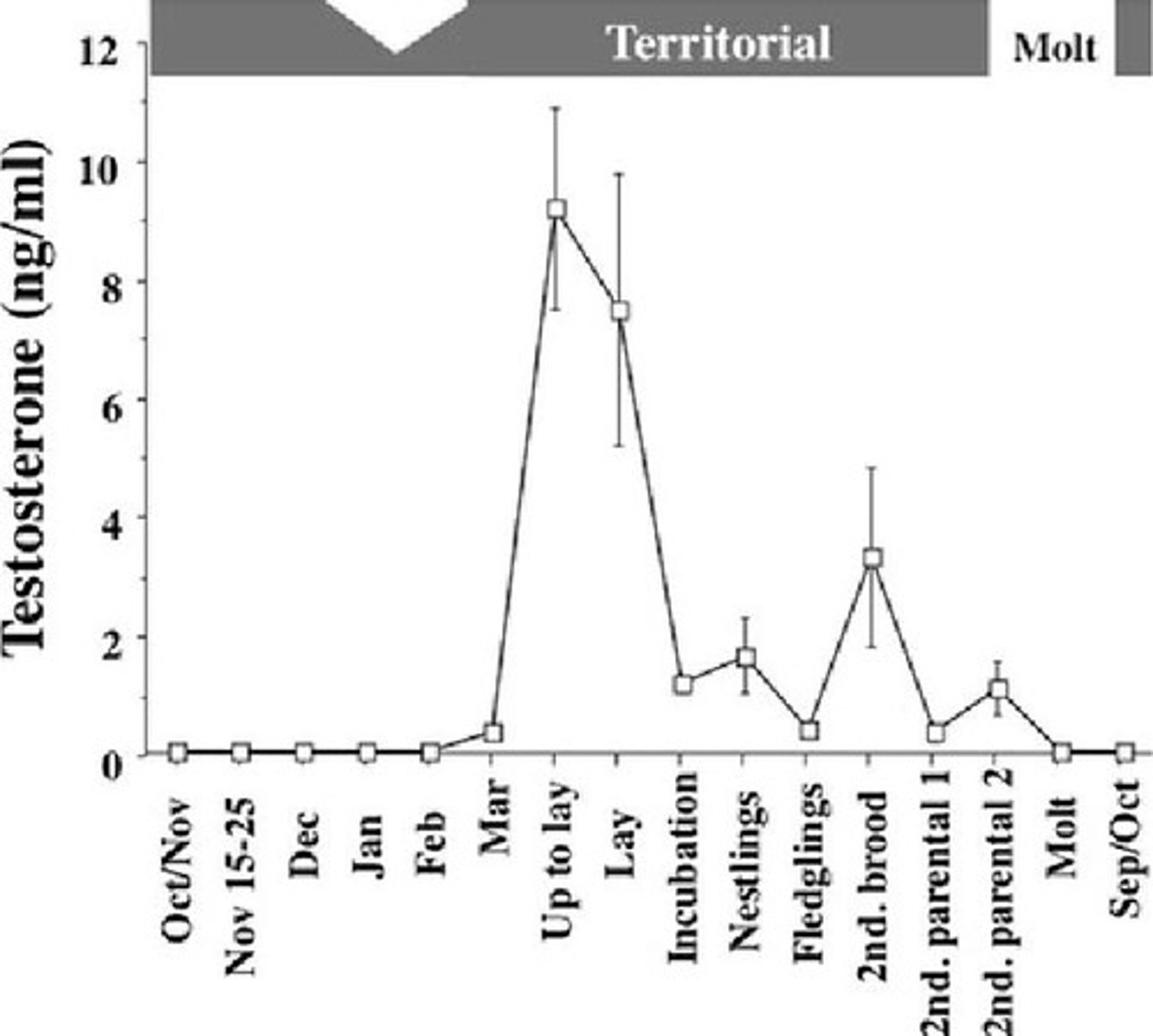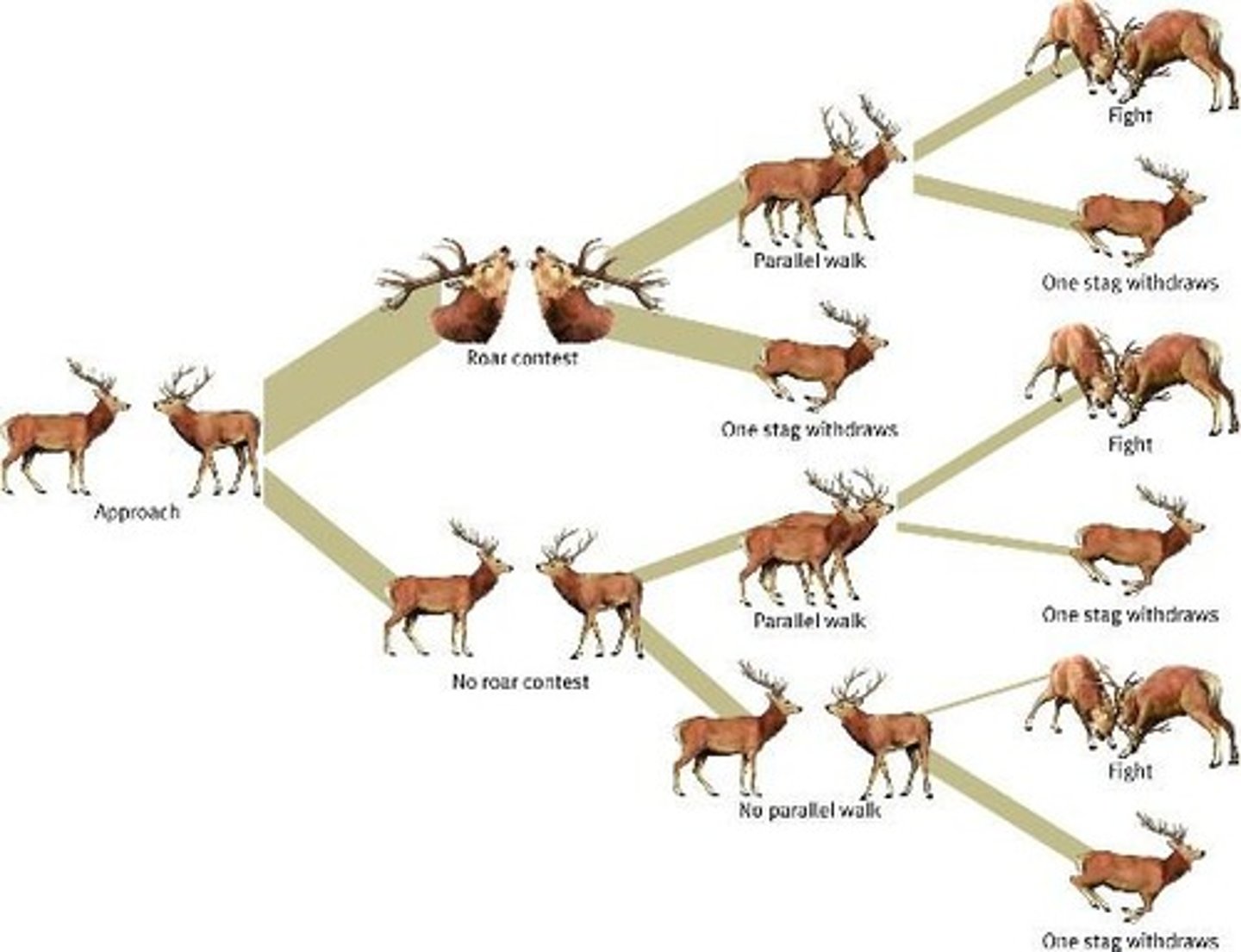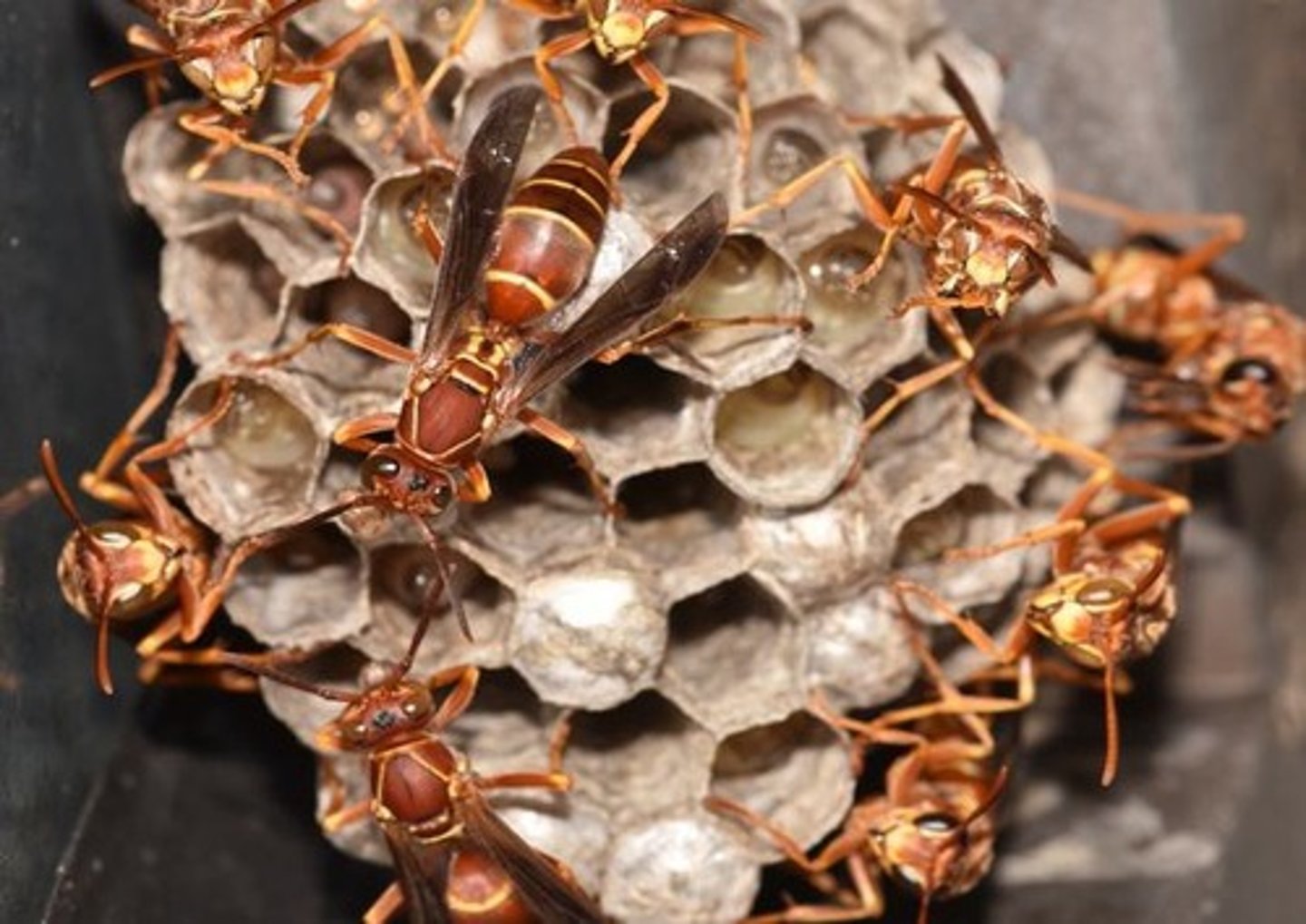Chapter 17-Animal Conflict Behaviors: Aggression, Hierarchies, and Territoriality
1/67
There's no tags or description
Looks like no tags are added yet.
Name | Mastery | Learn | Test | Matching | Spaced |
|---|
No study sessions yet.
68 Terms
What are the two terms used by animal behaviorists to describe aggression?
Aggression and agonistic behavior.
How is aggression defined in the context of animal behavior?
As a behavior intended to inflict noxious stimulation or destruction on another organism.
What types of aggression exist in animal interactions?
Aggression can be interspecific (between different species) and intraspecific (within the same species).
What biological advantages can aggression confer to animals?
Aggression can help secure territory, mating opportunities, and provide self-protection or protection for offspring.
What hormone is primarily linked to physical aggression in many species?
Testosterone.
How does testosterone affect aggression in females?
Females may have lower testosterone levels but can still exhibit increased aggression in some species.
What does the Challenge Hypothesis propose?
It outlines the relationship between plasma testosterone levels and aggression in mating contexts, suggesting testosterone increases aggression when beneficial for reproduction.

What role does Dehydroepiandrosterone (DHEA) play in aggression?
DHEA can be rapidly metabolized into potent androgens and estrogens, influencing aggression during non-breeding seasons.
What is the effect of glucocorticoid hormones on aggression?
Glucocorticoids, like corticosterone, can promote aggressive behavior, with low levels potentially causing aggression and chronic reduction leading to abnormal aggression.
What is agonistic behavior?
Any social behavior related to fighting, including threats, displays, retreats, and conciliation.
What types of interactions does agonistic behavior encompass?
Agonistic behavior includes all conflict between conspecifics (members of the same species).
What are the three kinds of behaviors that constitute agonistic interaction?
Threat, agonistic fighting, and submission.
What is threat behavior in animals?
Any behavior that signifies hostility or intent to attack another animal, meant to cause the opponent to back down.
How does agonistic fighting differ from threat behavior?
Agonistic fighting escalates from an indecisive threat display and involves actual physical confrontation.
What factors influence whether animals engage in actual fighting?
Fighting is more likely when individuals are similarly sized or when the contested resource is critical for reproduction or survival.
What are some common displays of threat behavior in animals?
Hair bristling, feather ruffling, raising skin folds, displaying teeth or horns, and vocalizations.
What is the relationship between cortisol levels and aggression?
Lower cortisol levels are associated with reduced fear and stress, which can correlate with increased aggression.
What is the significance of ritualistic behavior in agonistic interactions?
Ritualistic behaviors are common and can prevent actual fighting by allowing animals to display strength without physical confrontation.
How do agonistic behaviors vary among species?
Agonistic behaviors can differ widely, influenced by the species' social structure and the resources being contested.
What is a common outcome of threat behavior in animals?
It often elicits other agonistic behaviors, such as displays of physical attributes, fighting, or submission.
What is the role of testosterone in seasonal breeders?
Testosterone levels rise with the onset of the breeding season to support reproductive functions.
What happens to aggression levels in non-breeding seasons?
Aggression may be regulated by non-gonadal steroids like DHEA, which can be elevated in non-breeding birds.
What is the relationship between baseline corticosterone levels and dominance in mice?
Adult mice with low baseline corticosterone levels are more likely to become dominant compared to those with high levels.
What is the significance of agonistic behavior in resource competition?
Agonistic behavior often arises from competition for resources like food or mates, influencing social hierarchies.
What is the purpose of fighting among black mambas (Dendroaspis polylepis)?
To secure mating rights to receptive females during the breeding season.
How long do fights between black mambas typically last?
Fights normally last a few minutes but can extend over an hour or more.
What behavior do black mambas exhibit during fights?
They show restraint by not using their venom on one another.
What is submissive behavior in animals?
An act or posture indicating that an individual will not challenge a dominant individual in a social group.
How does submissive behavior contribute to social hierarchies?
It helps maintain a dominance hierarchy among cooperating individuals with overlapping interests.
What is an example of submissive behavior in Bearded Dragons (Pogona vitticeps)?
Waving one front arm in a circular motion while resting on three legs.
What factors influence the type of agonistic behavior displayed by animals?
The likelihood of winning, which is often assessed by size and fighting ability.
What is the significance of relative fighting ability in animal conflicts?
It helps animals assess whether to engage in a fight based on their physical characteristics.
How does previous fighting experience affect future conflicts in animals?
Animals that have won previous conflicts are more likely to win future ones, while those that have lost are more likely to lose again.
What role does the value of a disputed resource play in animal conflicts?
The opponent needing the resource more will fight harder for it, potentially swaying the balance of power.
What is a dominance hierarchy?
The organization of individuals in a group that occurs when competition for resources leads to aggression.
What determines dominance within a social hierarchy?
Factors include relative fighting ability, experience, and sometimes social associations or inheritance.
How can social status be inherited in certain species?
In species like rhesus monkeys, female offspring are born to a hierarchical level immediately below that of their mother.
What role do hormones play in establishing dominance hierarchies?
Hormones can influence social status and dominance, as seen in species like the paper wasp and naked mole-rat.
What happens to reproductive function in sub-dominant naked mole-rats when the queen is removed?
The removal allows the reestablishment of reproductive function in sub-dominant individuals.
What is the relationship between aggression and resource competition in animal groups?
Aggression typically arises from competition for resources and breeding opportunities.
What is the impact of non-fighting conflict on animals?
Displays and other forms of non-fighting conflict consume energy and time that could be used for resource acquisition.
How do animals assess their opponents before engaging in conflict?
They evaluate physical characteristics and may engage in threat displays to gauge the likelihood of winning.
What is the agonistic behavior observed in jumping spiders (Zygoballus sexpunctatus)?
Males exhibit ritualized behavior by raising and spreading their legs and vibrating their abdomen to indicate size and strength.

Why might animals avoid fighting despite being aggressive?
The potential costs of injury or death may outweigh the benefits unless they have a strong indication of winning.
What is the significance of territory in animal conflicts?
Animals tend to fight harder for their own territory, and those that originally hold it are more likely to maintain control.
What is the role of glucocorticoids in dominance?
Glucocorticoids may influence dominance behaviors and hierarchies in various species.
What are glucocorticoids and their role in social hierarchies?
Glucocorticoids, also known as stress hormones, are signaling molecules produced by the adrenal glands that stimulate the fight or flight response and may influence dominance in social hierarchies.
How do glucocorticoid levels differ between dominant and subordinate individuals?
Higher ranking individuals tend to have much higher levels of circulating glucocorticoids compared to subdominant individuals.
What are some benefits of being dominant in a social hierarchy?
Dominant individuals have greater access to resources, more food, and reproductive benefits, often being the only ones allowed to breed.
How do dominant individuals affect breeding in social groups?
In some species, only the dominant individual breeds, suppressing breeding in others, as seen in eusocial insects and naked mole rats.

What percentage of offspring do alpha females in Painted Wolves produce?
Alpha females produce 76-82% of the offspring.
What are some costs associated with being dominant?
Being dominant can lead to adverse health effects such as immunosuppression, increased appetite, and osteoporosis due to elevated glucocorticoid levels.
How can subordinate individuals gain benefits without being dominant?
Subordinate individuals, such as sneaker males, can gain access to mates without defending a territory or establishing dominance.
What options do subordinate individuals have to change their status?
Subordinates can challenge the dominant individual, leave to form or join a new group, or band together to challenge dominance.
What is a home range in animal behavior?
A home range is an area where an animal carries out most of its normal activities.
What is a core area within a home range?
The core area is the central part of a home range where the animal spends most of its time.
How do home ranges and core areas relate to conspecifics?
Home ranges may overlap among different groups, while core areas are typically used by only one group.
What defines a territory in ethology?
A territory is a sociographical area that an animal consistently defends against conspecifics and sometimes other species.
What types of resources do territorial animals typically defend?
Territorial animals defend areas that contain nests, dens, mating sites, and sufficient food resources.
What is a common method of territory defense?
Defense often involves noticeable displays, which can be auditory or olfactory, rather than overt fights.
Is territoriality a fixed property of a species?
No, territoriality is not fixed and can vary; for example, European robins defend territories differently in breeding and winter seasons.
What factors influence the economics of holding a territory?
Benefits include exclusive access to resources, while costs involve defense and vigilance.
When is territoriality favored in relation to resource abundance?
Territoriality is favored when resources are moderately abundant; it is less beneficial when resources are very abundant or very rare.
How does resource distribution affect territoriality?
Territoriality is favored when resources are moderately aggregated; if resources are spread out, the cost of defense increases.
What role does intruder pressure play in territoriality?
The number of competitors for a resource affects the cost of defense; higher intruder pressure can make holding a territory less cost-effective.
What strategies can animals use to reduce the costs of maintaining a territory?
Strategies include banding together to share territory, choosing easier-to-defend territories, and using clear markers to define boundaries.
How do animals alert neighbors to potential intruders?
Territory holders may make a commotion to alert neighboring territory owners to threats, allowing for quicker and more cost-effective defense.
What is the significance of using well-marked territories?
Well-marked territories reduce the cost of defending the area by establishing clear boundaries that are generally respected by neighbors.